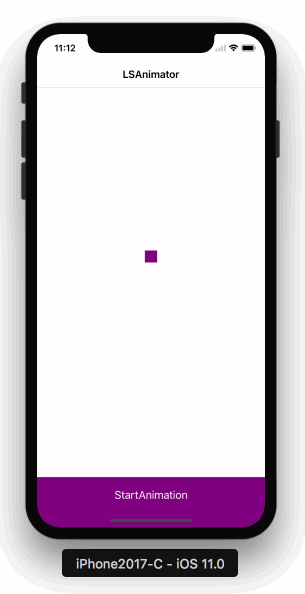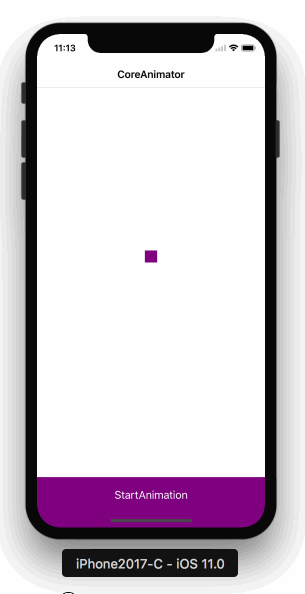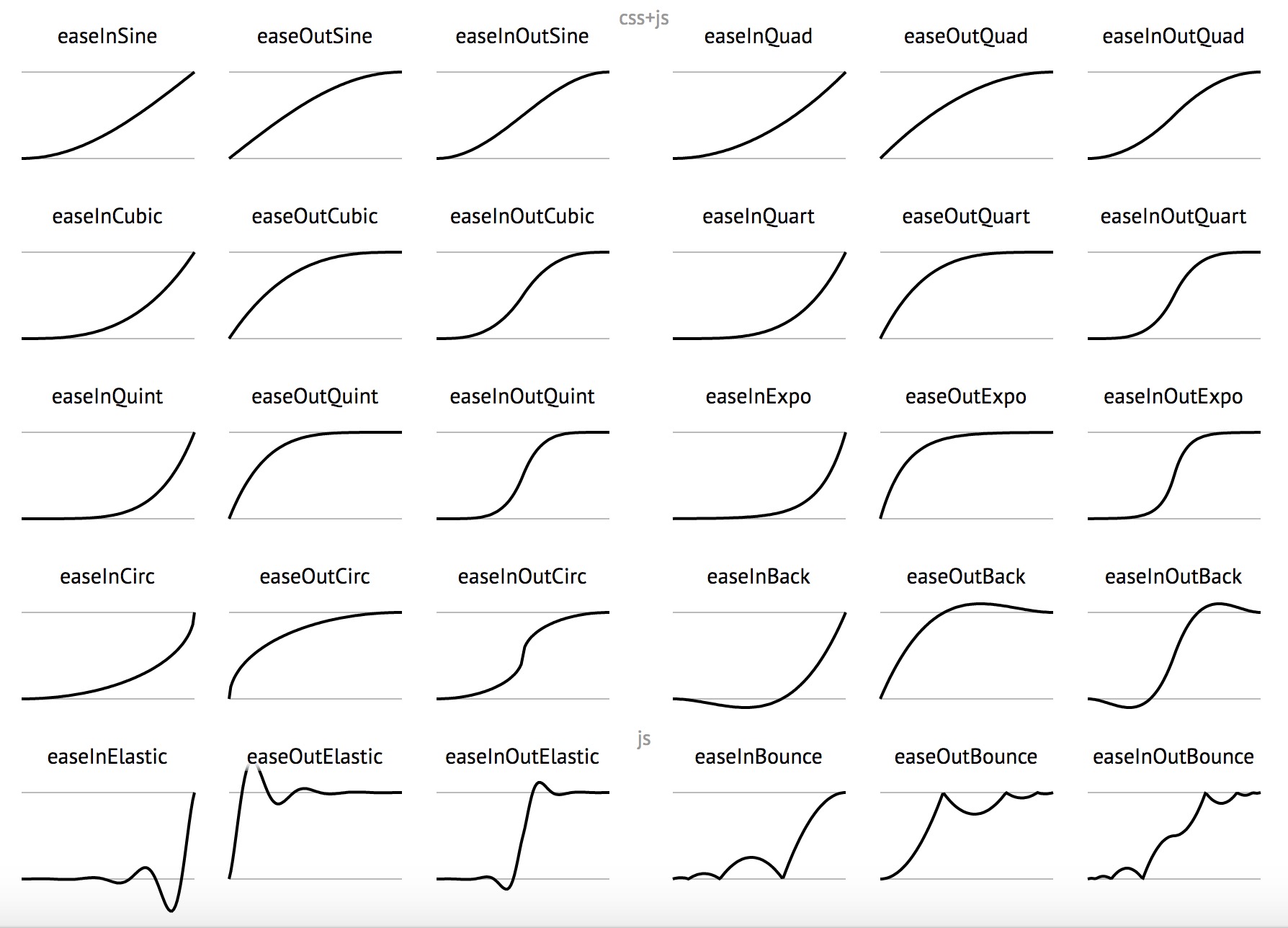This project is inspired by JHChainableAnimations!
You can write complex and easy-to-maintain animations in just a few lines of code by use LSAnimator(Objective-C) or CoreAnimator(Swift).
CAAnimations and UIView animations are extremely powerful, but it is very hard to read when the animation is complicated.
Say I want to move myView 100 pixels to the right with spring and then incre 30 pixels to the width with inward easing when the movement has finished:
[UIView animateWithDuration:2.0
delay:0.0
usingSpringWithDamping:0.8
initialSpringVelocity:1.0
options:0
animations:^{
CGPoint newPosition = self.myView.frame.origin;
newPosition.x += 100;
self.myView.frame = CGRectMake(newPosition.x, newPosition.y, self.myView.frame.size.width, self.myView.frame.size.height);
} completion:^(BOOL finished) {
[UIView animateWithDuration:2.0
delay:0.0
options:UIViewAnimationOptionCurveEaseIn
animations:^{
CGSize newSize = self.myView.frame.size;
newSize.width += 30;
self.myView.frame = CGRectMake(self.myView.frame.origin.x, self.myView.frame.origin.y, newSize.width, newSize.height);
} completion:nil];
}];Thats pretty gross huh... With LSAnimator it is one line of code.
LSAnimator *animator = [LSAnimator animatorWithView:self.myView];
animator.moveX(100).spring.thenAfter(2).increWidth(30).easeIn.animate(2);Emmmmm...There is an animation library called JHChainableAnimations can also do this.
JHChainableAnimations has powerful chainable animations AND easy to read/write syntax, but it does not support for Multi-chain Animations.
Following the example above, assume now that the whole animation chain above needs to change the transparency of myView to zero at the same time:
With LSAnimator it is just need to add one line of code.
LSAnimator *animator = [LSAnimator animatorWithView:self.myView];
animator.moveX(100).spring.thenAfter(2).increWidth(30).easeIn.animate(2);
animator.concurrent.makeOpacity(0).animate(4);Emmmmm...With JHChainableAnimations it is can not finished task. Trying to add the following code will cause the animation bug or crash.
JHChainableAnimator *animator = [[JHChainableAnimator alloc] initWithView:self.myView];
animator.moveX(100).spring.thenAfter(2).moveWidth(30).easeIn.animate(2);
animator.makeOpacity(0).animate(4);- Multi-chain Animations: Can complete all animation design needs, More flexible than JHChainableAnimations.
- CALayer Support: Support CALayer initialization, JHChainableAnimations only supports UIView.
- Parameter Auto-completion: Support parameter auto-completion, JHChainableAnimations does not support.
LSAnimator support parameter auto-completion, including the number of parameters and parameter types:
JHChainableAnimations is not friendly when actually writing code.
JHChainableAnimations is still a really good animation library and LSAnimator is standing on the shoulders of it.
- Swift Support: Swift 3.2 ~ 4 Support.
- Friendly Swift Interface: Added friendly Swift interface in separate framework.
- Multi-chain Animations: Can complete all animation design needs.
- CALayer Support: Support CALayer initialization.
- Parameter Auto-completion: Support parameter auto-completion.
- Support for Animation Hooks: Added pre-animation and post-animation hooks for each animation step. Added a final completion hook that fires when all animation chains have completed.
- Non-intrusive: There is no need to make the view/layer class inherit from other base class.
// UIView initialization
LSAnimator *viewAnimator = [LSAnimator animatorWithView:self.myView];
LSAnimator *viewAnimator = [[LSAnimator alloc] initWithView:self.myView];
// CALayer initialization
LSAnimator *layerAnimator = [LSAnimator animatorWithLayer:self.myLayer];
LSAnimator *layerAnimator = [[LSAnimator alloc] initWithLayer:self.myLayer];Chainable properties like moveX(x) must come between the animator and the animate(t) function.
Below is an example of how to double an objects size over the course of one second.
animator.makeScale(2.0).animate(1.0);If you want to move the view while you scale it, add another chainable property. Order is not important.
animator.makeScale(2.0).moveXY(100, 50).animate(1.0);
// the same as animator.moveXY(100, 50).makeScale(2.0).animate(1.0);Note: Combining Animations works only for the animation that needs to be done in the same step.
If the animations have different durations. When they can not be done in the same animation step, they need to use Multi-chain Animations.
A full list of chainable properties can be found here.
To chain animations seperate the chains with the thenAfter(t) function.
Below is an example of how to scale and object for 0.5 seconds, and then move it for 1 second when that is done.
animator.makeScale(2.0).thenAfter(0.5).moveXY(100, 50).animate(1.0);Animation Effects To add an animation effect, call the effect method after the chainable property you want it to apply to.
Below is an example of scaling a view with a spring effect.
animator.makeScale(2.0).spring.animate(1.0);If you add 2 to the same chainable property the second will cancel the first out.
animator.makeScale(2.0).bounce.spring.animate(1.0);
// The same as animator.makeScale(2.0).spring.animate(1.0);A full list of animation effect properties can be found here.
To anchor your view call an achoring method at some point in an animation chain. Like effects, calling one after another in the same chain will cancel the first out.
Below is an example of rotating a view around different anchor points.
animator.rotateZ(180).anchorTopLeft.thenAfter(1.0).rotateZ(90).anchorCenter.animate(1.0);
// animator.rotateZ(90).anchorTopLeft.anchorCenter == animator.rotateZ(90).anchorCenterA full list of anchor properties can be found here.
To delay an animation call the wait(t) or delay(t) chainable property.
Below is an example of moving a view after a delay of 0.5 seconds.
animator.moveXY(100, 50).wait(0.5).animate(1.0);
// The same as animator.moveXY(100, 50).delay(0.5).animate(1.0);To run code after an animation finishes call the animateWithCompletion(t, completion)* function.
animator.makeX(0).animateWithCompletion(1.0, ^{
NSLog(@"Animation Done");
});You can repeat an animation by replacing the thenAfter(time) method with the repeat(time, count) method. This will repeat the previously defined animations.
animator.increWidth(30).spring.repeat(0.5, 3).moveXY(100, 50).animate(1.0);You can repeat the last part of an animation by calling animateWithRepeat(time, count).
animator.increWidth(30).spring.animateWithRepeat(0.5, 3);You can hook into the different steps of the animation process by calling the preAnimationBlock(block) and postAnimationBlock(block) methods. All take a simple block void(^block)(void) as an argument. Order of calling these in the animation chain does not matter.
animator.moveX(10).preAnimationBlock(^{
NSLog(@"before the first animation");
}).thenAfter(1.0).postAnimationBlock(^{
NSLog(@"After the second animation");
}).moveY(10).animate(1.0);You can also animate a view along a UIBezierPath. Create a UIBezierPath * instance, then add points or curves or lines to it and use it in a chainable property.
UIBezierPath *path = [UIBezierPath bezierPath];
[path moveToPoint:self.myView.center];
[path addLineToPoint:CGPointMake(25, 400)];
[path addLineToPoint:CGPointMake(300, 500)];
animator.moveOnPath(path).animate(1.0);Use the transform chainable properties. These are better for views constrained with Autolayout. You should not mix these with other chainable properties.
animatorForViewWithConstraints.transformX(50).transformScale(2).animate(1.0);Using LSAnimator with Swift is now a little more readable in version 2.x. I created a separate framework for swift that provides a class called CoreAnimator. This is a thin wrapper over LSAnimator that has a slightly more readable syntax.
let animator = CoreAnimator(view: myView)
animator.move(x: 60).thenAfter(t: 1.0).rotate(angle: 360).bounce.animate(t: 1.0)#pragma mark - Animations
// Makes
// Affects views position and bounds
@property (nonatomic, copy, readonly) LSAnimatorRect makeFrame;
@property (nonatomic, copy, readonly) LSAnimatorRect makeBounds;
@property (nonatomic, copy, readonly) LSAnimatorSize makeSize;
@property (nonatomic, copy, readonly) LSAnimatorPoint makeOrigin;
@property (nonatomic, copy, readonly) LSAnimatorPoint makePosition;
@property (nonatomic, copy, readonly) LSAnimatorFloat makeX;
@property (nonatomic, copy, readonly) LSAnimatorFloat makeY;
@property (nonatomic, copy, readonly) LSAnimatorFloat makeWidth;
@property (nonatomic, copy, readonly) LSAnimatorFloat makeHeight;
@property (nonatomic, copy, readonly) LSAnimatorFloat makeOpacity;
@property (nonatomic, copy, readonly) LSAnimatorColor makeBackground;
@property (nonatomic, copy, readonly) LSAnimatorColor makeBorderColor;
@property (nonatomic, copy, readonly) LSAnimatorFloat makeBorderWidth;
@property (nonatomic, copy, readonly) LSAnimatorFloat makeCornerRadius;
@property (nonatomic, copy, readonly) LSAnimatorFloat makeScale;
@property (nonatomic, copy, readonly) LSAnimatorFloat makeScaleX;
@property (nonatomic, copy, readonly) LSAnimatorFloat makeScaleY;
@property (nonatomic, copy, readonly) LSAnimatorPoint makeAnchor;
// Moves
// Affects views position and bounds
@property (nonatomic, copy, readonly) LSAnimatorFloat moveX;
@property (nonatomic, copy, readonly) LSAnimatorFloat moveY;
@property (nonatomic, copy, readonly) LSAnimatorPoint moveXY;
@property (nonatomic, copy, readonly) LSAnimatorPolarCoordinate movePolar;
// Increments
// Affects views position and bounds
@property (nonatomic, copy, readonly) LSAnimatorFloat increWidth;
@property (nonatomic, copy, readonly) LSAnimatorFloat increHeight;
@property (nonatomic, copy, readonly) LSAnimatorSize increSize;
// Transforms
// Affects views transform property NOT position and bounds
// These should be used for AutoLayout
// These should NOT be mixed with properties that affect position and bounds
- (LSAnimator *)transformIdentity;
@property (nonatomic, copy, readonly) LSAnimatorDegrees rotate; // Same as rotateZ
@property (nonatomic, copy, readonly) LSAnimatorDegrees rotateX;
@property (nonatomic, copy, readonly) LSAnimatorDegrees rotateY;
@property (nonatomic, copy, readonly) LSAnimatorDegrees rotateZ;
@property (nonatomic, copy, readonly) LSAnimatorFloat transformX;
@property (nonatomic, copy, readonly) LSAnimatorFloat transformY;
@property (nonatomic, copy, readonly) LSAnimatorFloat transformZ;
@property (nonatomic, copy, readonly) LSAnimatorPoint transformXY;
@property (nonatomic, copy, readonly) LSAnimatorFloat transformScale; // x and y equal
@property (nonatomic, copy, readonly) LSAnimatorFloat transformScaleX;
@property (nonatomic, copy, readonly) LSAnimatorFloat transformScaleY;
#pragma mark - Bezier Paths
// Animation effects dont apply
@property (nonatomic, copy, readonly) LSAnimatorBezierPath moveOnPath;
@property (nonatomic, copy, readonly) LSAnimatorBezierPath moveAndRotateOnPath;
@property (nonatomic, copy, readonly) LSAnimatorBezierPath moveAndReverseRotateOnPath;- (LSAnimator *)easeIn;
- (LSAnimator *)easeOut;
- (LSAnimator *)easeInOut;
- (LSAnimator *)easeBack;
- (LSAnimator *)spring;
- (LSAnimator *)bounce;
- (LSAnimator *)easeInQuad;
- (LSAnimator *)easeOutQuad;
- (LSAnimator *)easeInOutQuad;
- (LSAnimator *)easeInCubic;
- (LSAnimator *)easeOutCubic;
- (LSAnimator *)easeInOutCubic;
- (LSAnimator *)easeInQuart;
- (LSAnimator *)easeOutQuart;
- (LSAnimator *)easeInOutQuart;
- (LSAnimator *)easeInQuint;
- (LSAnimator *)easeOutQuint;
- (LSAnimator *)easeInOutQuint;
- (LSAnimator *)easeInSine;
- (LSAnimator *)easeOutSine;
- (LSAnimator *)easeInOutSine;
- (LSAnimator *)easeInExpo;
- (LSAnimator *)easeOutExpo;
- (LSAnimator *)easeInOutExpo;
- (LSAnimator *)easeInCirc;
- (LSAnimator *)easeOutCirc;
- (LSAnimator *)easeInOutCirc;
- (LSAnimator *)easeInElastic;
- (LSAnimator *)easeOutElastic;
- (LSAnimator *)easeInOutElastic;
- (LSAnimator *)easeInBack;
- (LSAnimator *)easeOutBack;
- (LSAnimator *)easeInOutBack;
- (LSAnimator *)easeInBounce;
- (LSAnimator *)easeOutBounce;
- (LSAnimator *)easeInOutBounce;A quick look at these funcs can be found here
These animation functions were taken from a cool keyframe animation library that can be found here
They are based off of JQuery easing functions that can be found here
- (LSAnimator *)anchorDefault;
- (LSAnimator *)anchorCenter;
- (LSAnimator *)anchorTop;
- (LSAnimator *)anchorBottom;
- (LSAnimator *)anchorLeft;
- (LSAnimator *)anchorRight;
- (LSAnimator *)anchorTopLeft;
- (LSAnimator *)anchorTopRight;
- (LSAnimator *)anchorBottomLeft;
- (LSAnimator *)anchorBottomRight;You can add a new animation chain by calling the concurrency method. It does not affect the previous animation chains.
animator.increWidth(20).spring.animateWithRepeat(0.5, 3);
animator.concurrent.makeBackground([UIColor orangeColor]).animate(1);Do not change the properties of the animation chain before the new animation chain operates at the same time.
// Do not do this
animator.moveX(20).animate(1.0);
animator.concurrent.moveX(-20).animate(1.0);- Constraint animator
- Add
pod 'LSAnimator', '~> 2.1.3'to your Podfile. - Run
pod installorpod update. - Add
#import <LSAnimator/LSAnimator.h>.
- Add
pod 'CoreAnimator', '~> 2.1.3'to your Podfile. - Run
pod installorpod update. - Add
import CoreAnimator.
- Add
github "Lision/LSAnimator" ~> 2.1.3to your Cartfile. - Run
carthage update --platform ios.
Add the LSAnimator framework to your project.
Add the CoreAnimator framework to your project.
Either clone the repo and manually add the Files in LSAnimator
- LSAnimator requires
iOS 7.0+. - CoreAnimator requires
iOS 9.0+.
- Email: [email protected]
- Sina: @Lision
- Twitter: @Lision
LSAnimator is provided under the MIT license. See LICENSE file for details.


























